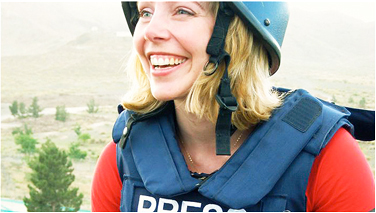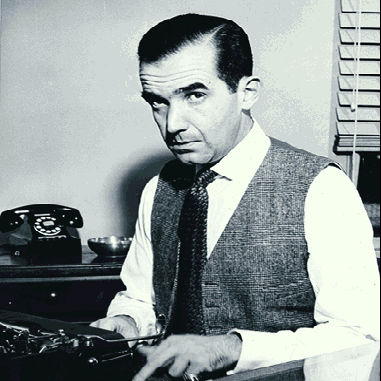I saw the news item like most of you probably did: CBS News Hires Digital Journalist to be Based in Afghanistan. Yup.

CBS' Mandy Clark
Who says the networks are shying away from covering highly important yet massively dangerous overseas stories? Not CBS, snatching up former Voice of America VJ Mandy Clark, handing her a camera and a laptop (and hopefully battle armor) and sending her off into the poppy fields to see what the Taliban and al Qaeda are up to.
Maybe you had the reaction I did: seriously?
CBS News Senior Vice President Paul Friedman said in a release on the hire: “Mandy is intrepid and her wealth of experience reporting from the Middle East, Central Asia and elsewhere and her adroit use of technology, make her a terrific addition.” Hmm. If you’ve read CBS News correspondent Kimberly Dozier’s gripping book about the Iraqi bombing that took the life of her two-man crew and nearly killed her, you know that in a war zone, even the most routine walk and talks surrounded by the toughest, heavily armed American soldiers is sometimes no guarantee you’ll live to file your story. Dozier and her crew debated the safety of every assignment and argued pros and cons. Dozier’s in-country producer was a key player in raising alarm bells when the crew didn’t report in as expected, ultimately involving CBS brass in New York immediately and leading to Dozier’s air evacuation to a hospital where doctors are credited with saving her life.

CBS' Kimberly Dozier After Bombing
It makes me think about the levels of protection a one-man-band doesn’t have in a place like Afghanistan–even something as simple as a second (or third) set of eyes to watch the horizon for a fast-approaching Toyota in the sand while shooting video of something the Taliban might prefer not make air on Katie Couric’s newscast.
Clark’s come close already. In a recent assignment, she described getting caught in a firefight: “Then an explosion of sound. Gunfire was coming from everywhere, all at once. I lay my back against an alcove of rocks. A soldier was right in front of me firing at the surrounding hills. I pointed my camera but had to turn my head away because my skin was being pelted by his spent bullet casings. There were commands and curses flying all around, along with the bullets and rockets. I remember trying to just focus on what I was filming. I knew this was an important story and I wanted to tell it right, to get the pictures just right. If my shots were too sloppy, they wouldn’t bring the viewer to the battle.”
I don’t know Mandy Clark, and have only seen one of her stories on CBS. But I wonder how fast a decision like this–so high profile–will filter down to local stations already looking to expand their fleets of “digital journalists.” Hey, why not send a solo photographer off to Iraq? It’s been done, right? How about maximizing our hurricane or tornado coverage? Drive yourself into the worst of the storm, get what you can and hey, don’t forget to shoot a standup. And be careful! You know your safety is more important to us than any story.

Another War, Another World: CBS' Murrow in London, 1944
Murrow and his boys demonstrated the unique power of war reporting to captivate listeners and viewers. “This… is London” still resonates with Americans who can remember hearing it. All war reporting is dangerous. But going it alone?
Why do I feel so uncomfortable?


 DISPATCH FROM THE FRONTLINES: STEVE COCHRANE, CO-FOUNDER, VidSF
DISPATCH FROM THE FRONTLINES: STEVE COCHRANE, CO-FOUNDER, VidSF
 Think of the evolution of job titles in local news over the last few years: out goes “studio camera operator,” in comes “robotics camera operator.” I guess there was a specific title for the guys who developed the film (“footage,” as the interns still call it), a job long gone before I showed up on the local newser scene, and now we have “ingest coordinators.” And at WUSA/DC, they have a “Digital Development Director,” in the form of tech savvy Patrick O’Brien. And please, stay on his good side by not suggesting that he’s the guy who runs Channel 9’s website. How 1990s of you. No. He’s the Main Man of Multimedia at Gannett’s flagship, which made major local newser news by becoming the first big-city station in the country to go all video journalist, ending the era of two-person field crews.
Think of the evolution of job titles in local news over the last few years: out goes “studio camera operator,” in comes “robotics camera operator.” I guess there was a specific title for the guys who developed the film (“footage,” as the interns still call it), a job long gone before I showed up on the local newser scene, and now we have “ingest coordinators.” And at WUSA/DC, they have a “Digital Development Director,” in the form of tech savvy Patrick O’Brien. And please, stay on his good side by not suggesting that he’s the guy who runs Channel 9’s website. How 1990s of you. No. He’s the Main Man of Multimedia at Gannett’s flagship, which made major local newser news by becoming the first big-city station in the country to go all video journalist, ending the era of two-person field crews.



